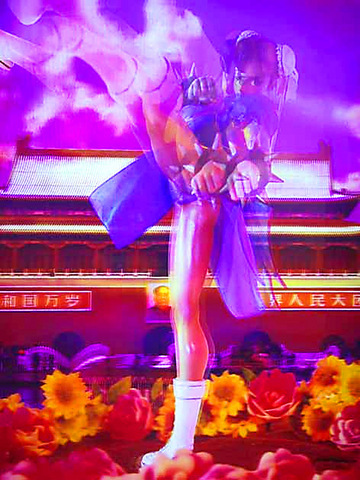If you didn't make the gala party last week at the British Trade and Cultural Office Residence in Yangmingshan, the first time an exhibition of local art has been shown at a diplomatic residence, you can still see the avant-garde art that was exhibited and which is now being shown at the Taipei MOMA Gallery.
Entitled A Peep into Taiwanese Contemporary Photography the exhibition brings together several of the hottest Taiwanese artists working today.
The party was an important event as it merged two audiences that normally do not cross paths: those working in the foreign services and those in the art world. The exhibition helped to broaden the audience for the local art while also highlighting the importance of cultural exchanges.

PHOTOS COURTESY OF TAIPEI MOMA
The concise exhibition at the gallery contains digital imagery, video and photographs by some of the top Taiwanese artists and provides a general overview of what is happening currently in art. This is a great opportunity to see the work of some of the best artists in Taiwan.
For some flashy images, Hung Tung-lu's (
Wu Tien-chang's (

On view are two video works that range from deeply somber to sidesplitting slapstick. Chen Chieh-ren's (
In contrast, the lighthearted and humorous videos of Tsui Kuang-yu (
Taipei MOMA Gallery is at 3F, 19, Ln 252, Dunhua S Rd, Sec 1, Taipei (
Besides this, there are several exhibitions about town. If you're still in a photographic mood, then go to TIVAC to see its current show of Taiwanese and German photographers. Taiwan International Visual Arts Center, 1 F, 29, Ln 45, Liaoning Street (
Song of the Wanderer -- Taiwan German Photography Exhibition includes work by Ulrike Myrzik and Manfred Jarisch, with the theme "Architecture of the Homeless." Ho Ching-tai (
At the Main Trend Gallery there is a solo show by Chang Chen-jen (
Taking place simultaneously, in Kaohsiung at the Sin Pin Pier and at the Birmingham Institute of Art and Design in Birmingham, England, Seesaw is a conceptual art exhibition that tries to merge two time-zones via digital art. The exhibition includes the work of UK artists and of Taiwanese artists. Since the works are electronic, they disappear when switched off; therefore the art seesaws between the two cities separated by an eight-hour time difference.
Hsu Su-chen (

Seven hundred job applications. One interview. Marco Mascaro arrived in Taiwan last year with a PhD in engineering physics and years of experience at a European research center. He thought his Gold Card would guarantee him a foothold in Taiwan’s job market. “It’s marketed as if Taiwan really needs you,” the 33-year-old Italian says. “The reality is that companies here don’t really need us.” The Employment Gold Card was designed to fix Taiwan’s labor shortage by offering foreign professionals a combined resident visa and open work permit valid for three years. But for many, like Mascaro, the welcome mat ends at the door. A

Last week gave us the droll little comedy of People’s Republic of China’s (PRC) consul general in Osaka posting a threat on X in response to Japanese Prime Minister Sanae Takaichi saying to the Diet that a Chinese attack on Taiwan may be an “existential threat” to Japan. That would allow Japanese Self Defence Forces to respond militarily. The PRC representative then said that if a “filthy neck sticks itself in uninvited, we will cut it off without a moment’s hesitation. Are you prepared for that?” This was widely, and probably deliberately, construed as a threat to behead Takaichi, though it

Nov. 17 to Nov. 23 When Kanori Ino surveyed Taipei’s Indigenous settlements in 1896, he found a culture that was fading. Although there was still a “clear line of distinction” between the Ketagalan people and the neighboring Han settlers that had been arriving over the previous 200 years, the former had largely adopted the customs and language of the latter. “Fortunately, some elders still remember their past customs and language. But if we do not hurry and record them now, future researchers will have nothing left but to weep amid the ruins of Indigenous settlements,” he wrote in the Journal of

If China attacks, will Taiwanese be willing to fight? Analysts of certain types obsess over questions like this, especially military analysts and those with an ax to grind as to whether Taiwan is worth defending, or should be cut loose to appease Beijing. Fellow columnist Michael Turton in “Notes from Central Taiwan: Willing to fight for the homeland” (Nov. 6, page 12) provides a superb analysis of this topic, how it is used and manipulated to political ends and what the underlying data shows. The problem is that most analysis is centered around polling data, which as Turton observes, “many of these